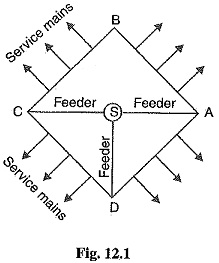Electric Power Distribution System:
Electric Power Distribution System states that part of power system which distributes electric power for local use is known as distribution system.
The electrical energy produced at the generating station is conveyed to the consumers through a network of transmission and distribution systems. It is often difficult to draw a line between the transmission and distribution systems of a large power system. It is impossible to distinguish the two merely by their voltage because what was considered as a high voltage a few years ago is now considered as a low voltage. In general, Electric Power Distribution System is that part of power system which distributes power to the consumers for utilization.
The transmission and distribution systems are similar to man’s circulatory system. The transmission system may be compared with arteries in the human body and distribution system with capillaries. They serve the same purpose of supplying the ultimate consumer in the city with the life-giving blood of civilization electricity. In this chapter, we shall confine our attention to the general introduction to Electric Power Distribution System.
In general, the distribution system is the electrical system between the sub-station fed by the transmission system and the consumers meters. It generally consists of feeders, distributors and the service mains. Fig. 12.1 shows the single line diagram of a typical low tension Electric Power Distribution System.
- Feeders: A feeder is a conductor which connects the sub-station (or localised generating station) to the area where power is to be distributed. Generally, no tappings are taken from the feeder so that current in it remains the same throughout. The main consideration in the design of a feeder is the current carrying capacity.
- Distributor: A distributor is a conductor from which tappings are taken for supply to the consumers. In Fig. 12.1, AB, BC, CD and DA are the distributors. The current through a distributor is not constant because tappings are taken at various places along its length. While designing a distributor, voltage drop along its length is the main consideration since the statutory limit of voltage variations is ± 6% of rated value at the consumers terminals.
- Service mains: A service mains is generally a small cable which connects the distributor to the consumers terminals.
Classification of Distribution Systems:
A distribution system may be classified according to ;
- Nature of current: According to nature of current, distribution system may be classified as (a) d.c. distribution system (b) a.c. distribution system. Now-a-days, a.c. system is universally adopted for distribution of electric power as it is simpler and more economical than direct current method.
- Type of construction: According to type of construction, distribution system may be classified as (a) overhead system (b) underground system. The overhead system is generally employed for distribution as it is 5 to 10 times cheaper than the equivalent underground system. In general, the underground system is used at places where overhead construction is impracticable or prohibited by the local laws.
- Scheme of connection: According to scheme of connection, the Electric Power Distribution System may be classified as (a) radial system (b) ring main system (c) inter-connected system.
